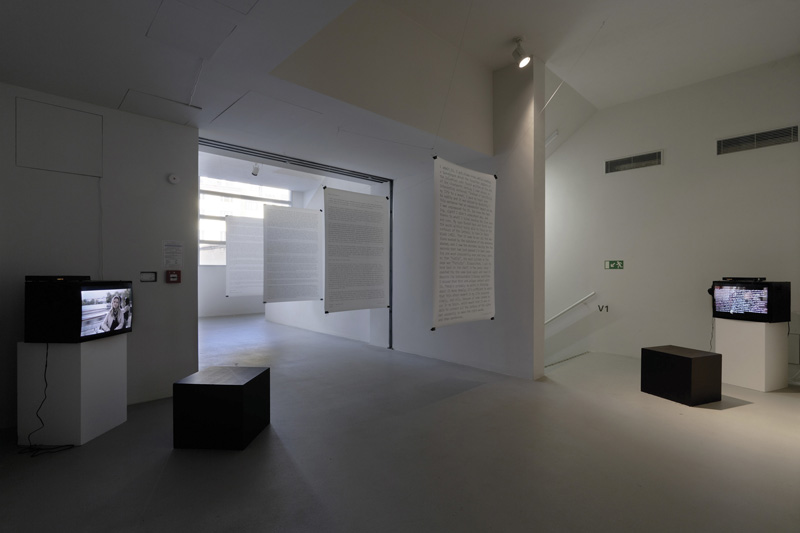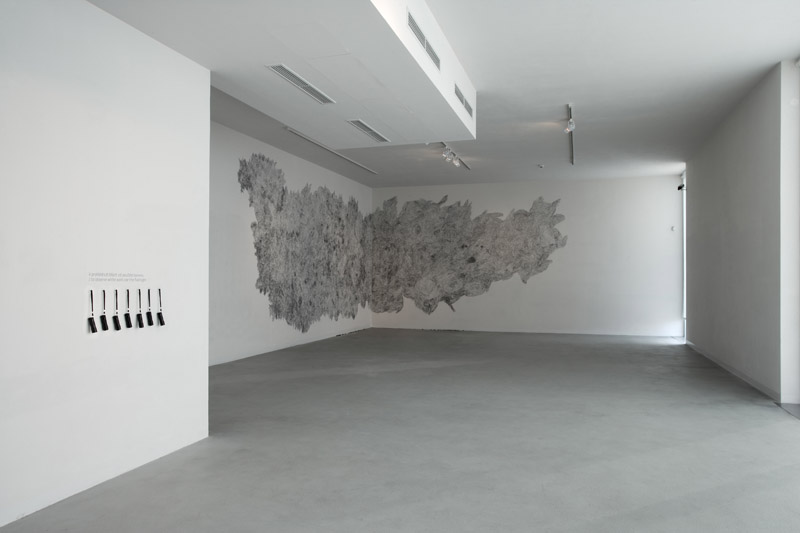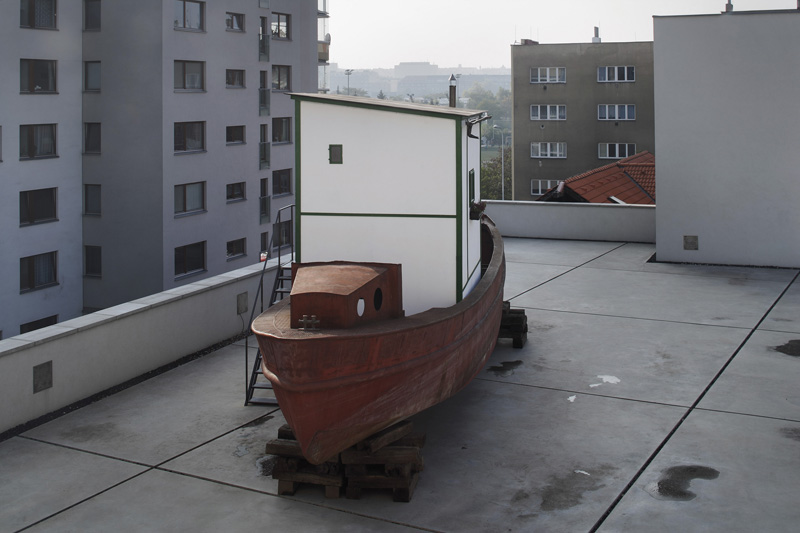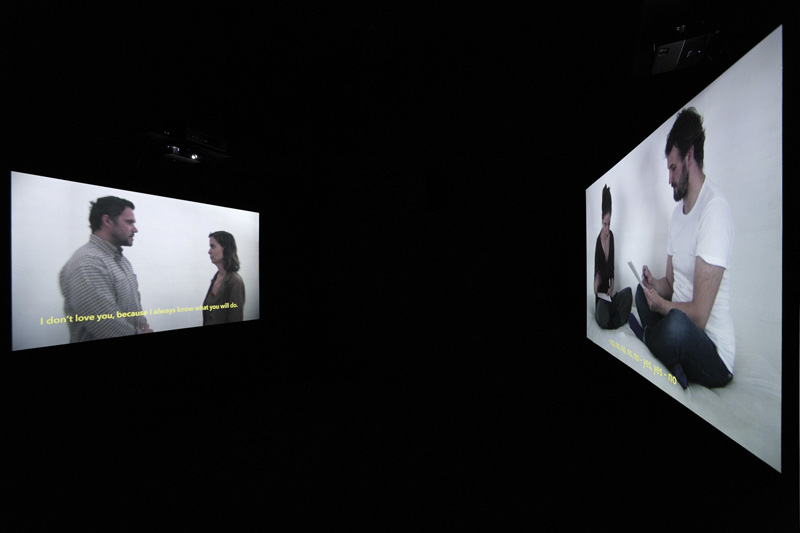The 2009 Jindřich Chalupecký Award (Review)
 Every year, the Czech art scene impatiently awaits five nominations for the final round of the Jind?ich Chalupecký award, open to young artists under the age of thirty-five. Although the prize is awarded for long term contributions to the Czech art scene, the final verdict depends more or less on new works that are exhibited in a show organized at the award event itself. This year, the exhibition was held at Dox, a center for contemporary art in Prague. The exhibition included works by Tomáš Džado? a Prague-based artist of Slovak origin, the art duo Ji?í Franta and David Böhm, Petra Herotová, Alena Kotzmanová, and the winner Ji?í Skála.
Every year, the Czech art scene impatiently awaits five nominations for the final round of the Jind?ich Chalupecký award, open to young artists under the age of thirty-five. Although the prize is awarded for long term contributions to the Czech art scene, the final verdict depends more or less on new works that are exhibited in a show organized at the award event itself. This year, the exhibition was held at Dox, a center for contemporary art in Prague. The exhibition included works by Tomáš Džado? a Prague-based artist of Slovak origin, the art duo Ji?í Franta and David Böhm, Petra Herotová, Alena Kotzmanová, and the winner Ji?í Skála.
 It comes as no surprise that the nominations have been followed by discussions about who was selected and why, and also why some strong artists nominated in previous years were this year missing from the list. Unfortunately, for the professional as well as the lay audience, some of the nominations have remained hard to justify. A fitting example is the work by Ji?í Franta and David Böhm entitled 58 years. In their work, Böhm and Franta elaborated on the idea of cooperation and dialogue, a concept continuously reappearing in most of their practice. Part of the installation presented a large abstract form, reminiscent of a map, which covered segments of two intersecting walls. The seemingly abstract form encrypts the age of the two artists; if added together, it equals the title of the work – 58 years. The size of the image is determined by the fifty-eight pencils used to draw it and then left as if forgotten under the drawing. The second part of the installation incorporated personal, in most cases trivial, diary type signs written in special ink and visible only when lit with a special flashlight. The works seemed slightly self-centered, with an undertone of the spectacular, reminiscent of a staged hide and seek game, an element unusual for most of their art practice.
It comes as no surprise that the nominations have been followed by discussions about who was selected and why, and also why some strong artists nominated in previous years were this year missing from the list. Unfortunately, for the professional as well as the lay audience, some of the nominations have remained hard to justify. A fitting example is the work by Ji?í Franta and David Böhm entitled 58 years. In their work, Böhm and Franta elaborated on the idea of cooperation and dialogue, a concept continuously reappearing in most of their practice. Part of the installation presented a large abstract form, reminiscent of a map, which covered segments of two intersecting walls. The seemingly abstract form encrypts the age of the two artists; if added together, it equals the title of the work – 58 years. The size of the image is determined by the fifty-eight pencils used to draw it and then left as if forgotten under the drawing. The second part of the installation incorporated personal, in most cases trivial, diary type signs written in special ink and visible only when lit with a special flashlight. The works seemed slightly self-centered, with an undertone of the spectacular, reminiscent of a staged hide and seek game, an element unusual for most of their art practice.
 In this year’s Jind?ich Chalupecký prize, the tendency to present rather ostentatious works seemed to be a reoccurring trend. Alena Kotzmanová, a photographer whose work is characterized primarily by a conceptual, slightly romantic approach to photography, exhibited a life size boat (193 m.a.s.l.) situated on the gallery roof. The viewers were meant to enter the main space of the boat where they were then presented with a series of old postcards of the sea arranged randomly on all interior walls of the boat. Due to the selection and archival nature of the photographs, the work bears an undeniably aesthetic quality. However, the subject of the work seemed to be rather superficial –its form in many respects dominated its content.
In this year’s Jind?ich Chalupecký prize, the tendency to present rather ostentatious works seemed to be a reoccurring trend. Alena Kotzmanová, a photographer whose work is characterized primarily by a conceptual, slightly romantic approach to photography, exhibited a life size boat (193 m.a.s.l.) situated on the gallery roof. The viewers were meant to enter the main space of the boat where they were then presented with a series of old postcards of the sea arranged randomly on all interior walls of the boat. Due to the selection and archival nature of the photographs, the work bears an undeniably aesthetic quality. However, the subject of the work seemed to be rather superficial –its form in many respects dominated its content.
 Compared to Kotzmanová, Petra Herotová, an artist respected for her unique, biographical, and often playful drawings with comic features, made the subject a clear base of her work. Petra Herotová and Petra Herotová, presents an investigation into the lives of two women of the same age and the same name , who nevertheless differ in their professions-one is an artist, the other an accountant-and in their outlooks and approaches to life. The installation consists of a video documenting their first meeting and discussion on subjects of everyday life. The rest of the installation then presents a vast series of diagrams, mapping the movement of the two women over the course of their lives and throughout the territory of the Czech Republic, detailing their various activities and shared interests, such as recycling. However, the museum-like installation and the large number of artifacts deriving from one event–i.e. their encounter–is strongly reminiscent of the practice of Kate?ina Šedá, the winner of the 2005 Jind?ich Chalupecký award.
Compared to Kotzmanová, Petra Herotová, an artist respected for her unique, biographical, and often playful drawings with comic features, made the subject a clear base of her work. Petra Herotová and Petra Herotová, presents an investigation into the lives of two women of the same age and the same name , who nevertheless differ in their professions-one is an artist, the other an accountant-and in their outlooks and approaches to life. The installation consists of a video documenting their first meeting and discussion on subjects of everyday life. The rest of the installation then presents a vast series of diagrams, mapping the movement of the two women over the course of their lives and throughout the territory of the Czech Republic, detailing their various activities and shared interests, such as recycling. However, the museum-like installation and the large number of artifacts deriving from one event–i.e. their encounter–is strongly reminiscent of the practice of Kate?ina Šedá, the winner of the 2005 Jind?ich Chalupecký award.
 Originality could definitely not be ascribed to Tomáš Džado?’s I have lost the instructions…, an architectural installation presenting prefab components of a high-rise apartment building where Džado? spent most of his childhood. Panel-like walls were stacked up against the walls of the gallery, some with windows, others with doors, one with a balcony. Prefab high-rise buildings have been appearing in Džado?’s art practice for some time. Through his large scale installations, Džado? deals with his “personal collective” mythology, arising from his childhood spent in this type of apartment project. It would be wrong to understand his work as merely an account of a personal past, however, as Džado?’s installations in many ways serve also to scrutinize the present, as prefab high rise architecture is an element still topical for Eastern European cities. In his work for the award, Džado? deals with the tension arising from a resistance towards the past coupled with his nostalgic perception of his childhood. Although there is no doubt about the undeniably high quality of I have lost the instructions…, its formal similarity with the artist’s previous works may bring a feeling of repetitiveness to viewer’s mind.
Originality could definitely not be ascribed to Tomáš Džado?’s I have lost the instructions…, an architectural installation presenting prefab components of a high-rise apartment building where Džado? spent most of his childhood. Panel-like walls were stacked up against the walls of the gallery, some with windows, others with doors, one with a balcony. Prefab high-rise buildings have been appearing in Džado?’s art practice for some time. Through his large scale installations, Džado? deals with his “personal collective” mythology, arising from his childhood spent in this type of apartment project. It would be wrong to understand his work as merely an account of a personal past, however, as Džado?’s installations in many ways serve also to scrutinize the present, as prefab high rise architecture is an element still topical for Eastern European cities. In his work for the award, Džado? deals with the tension arising from a resistance towards the past coupled with his nostalgic perception of his childhood. Although there is no doubt about the undeniably high quality of I have lost the instructions…, its formal similarity with the artist’s previous works may bring a feeling of repetitiveness to viewer’s mind.
Compared to the rest of the finalists mentioned above, the work by Ji?í Skála, the winner of the Chalupecký award, was different at first glance. files and media download here The installation was dominatedby text presented either in video installations or large posters, and four large texts in the form of letters and literary texts were suspended from the ceiling. The work narrates the many times ambiguous position of the artist towards painting, literature, photography, or the notion of archive. Two video installations positioned nearby presented a woman and a man. The man in the video reads aloud the diary of a Czech dissident. The woman in the other video listens with an expression of indifference to the love story of another woman.
 The core concept of all Skála’s exhibited works concerned the modes or means of recording/encoding messages. In one of the texts, he explains why he has deserted painting for writing. The same issue also surfaced in his two videos entitled Naming. The first mimics communication in digital media in the form of yes-no sequence dialogues between the artist and his girlfriend. The second likewise records a dialogue, this time using various permutations of several short sentences. The majority of Skála’s installation also applied the archival principle; the topic of archive appears in some of his exhibited text, such as an elderly man reading decade’s old diaries of a dissident. Furthermore, Skála extends the archival principle to his installation through the labels of his works, which resemble archive tags.
The core concept of all Skála’s exhibited works concerned the modes or means of recording/encoding messages. In one of the texts, he explains why he has deserted painting for writing. The same issue also surfaced in his two videos entitled Naming. The first mimics communication in digital media in the form of yes-no sequence dialogues between the artist and his girlfriend. The second likewise records a dialogue, this time using various permutations of several short sentences. The majority of Skála’s installation also applied the archival principle; the topic of archive appears in some of his exhibited text, such as an elderly man reading decade’s old diaries of a dissident. Furthermore, Skála extends the archival principle to his installation through the labels of his works, which resemble archive tags.
Compared to some of the previous years of the prize, such as 2008 (Radim Labuda) or 2006 when Barbora Klímová was the recipient, this years victory of Ji?í Skála has been accepted by the Czech art community without any major discussions. Although some opposing (rather conservative) voices have questioned the aesthetic quality of the work, namely pointing out the dominant textual nature of the peace, the majority of the public perceived Skála’s work as a compelling attempt to bring together key conceptual tendencies of Czech late modern and early postmodern art.





